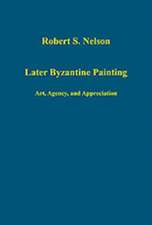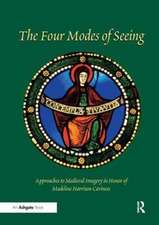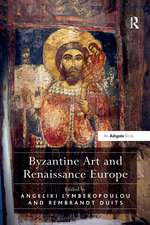Binding the Absent Body in Medieval and Modern Art: Abject, virtual, and alternate bodies
Editat de Emily Kelley, Elizabeth Richards Rivenbarken Limba Engleză Hardback – 21 oct 2016
| Toate formatele și edițiile | Preț | Express |
|---|---|---|
| Paperback (1) | 259.31 lei 6-8 săpt. | |
| Taylor & Francis – 23 mai 2019 | 259.31 lei 6-8 săpt. | |
| Hardback (1) | 823.59 lei 6-8 săpt. | |
| Taylor & Francis – 21 oct 2016 | 823.59 lei 6-8 săpt. |
Preț: 823.59 lei
Preț vechi: 1180.28 lei
-30% Nou
Puncte Express: 1235
Preț estimativ în valută:
157.59€ • 164.54$ • 130.43£
157.59€ • 164.54$ • 130.43£
Carte tipărită la comandă
Livrare economică 04-18 aprilie
Preluare comenzi: 021 569.72.76
Specificații
ISBN-13: 9781472459367
ISBN-10: 1472459369
Pagini: 212
Ilustrații: 70
Dimensiuni: 174 x 246 x 16 mm
Greutate: 0.66 kg
Ediția:1
Editura: Taylor & Francis
Colecția Routledge
Locul publicării:Oxford, United Kingdom
ISBN-10: 1472459369
Pagini: 212
Ilustrații: 70
Dimensiuni: 174 x 246 x 16 mm
Greutate: 0.66 kg
Ediția:1
Editura: Taylor & Francis
Colecția Routledge
Locul publicării:Oxford, United Kingdom
Cuprins
Table of Contents
List of Figures
List of Tables
Notes on Contributors
Introduction
Emily Kelley and Elizabeth Richards Rivenbark
The Abject Body
Chapter 1: Blood, Sweat, Tears, and Milk: ‘Fluid’ Veneration in Medieval Devotional Art
Vibeke Olson
Chapter 2: "No Living Presence": Human Absence in the Early Work of Jasper Johns and Robert Rauschenberg
Rebekah Scoggins
The Virtual Body
Chapter 3: Maria Ecclesia: The Aachen Marienschrein as an Alternate Body for the Virgin Mary
Lisa Ciresi
Chapter 4: Drawn to Scale: The Medieval Monastic’s Virtual Pilgrimage through Sacred Measurement
Natalie Mandziuk
Chapter 5: Cloth as a Sign of the Absent Body in American Sculpture from the 1960s
Elizabeth Richards Rivenbark
The Alternate Body
Chapter 6: Imagining the Sorrows of Death and Pains of Hell in the Hours of Catherine of Cleves
Jennifer Feltman
Chapter 7: The Absent Body as Divine Reflection in Parmigianino’s Self-Portrait in a Convex Mirror
Margaret Morse
Chapter 8: A Clear Preoccupation with Death: The Absent Body in Mark Rothko’s Mature Style
Michael R. Smith, Jr.
Bibliography
Index
List of Figures
List of Tables
Notes on Contributors
Introduction
Emily Kelley and Elizabeth Richards Rivenbark
The Abject Body
Chapter 1: Blood, Sweat, Tears, and Milk: ‘Fluid’ Veneration in Medieval Devotional Art
Vibeke Olson
Chapter 2: "No Living Presence": Human Absence in the Early Work of Jasper Johns and Robert Rauschenberg
Rebekah Scoggins
The Virtual Body
Chapter 3: Maria Ecclesia: The Aachen Marienschrein as an Alternate Body for the Virgin Mary
Lisa Ciresi
Chapter 4: Drawn to Scale: The Medieval Monastic’s Virtual Pilgrimage through Sacred Measurement
Natalie Mandziuk
Chapter 5: Cloth as a Sign of the Absent Body in American Sculpture from the 1960s
Elizabeth Richards Rivenbark
The Alternate Body
Chapter 6: Imagining the Sorrows of Death and Pains of Hell in the Hours of Catherine of Cleves
Jennifer Feltman
Chapter 7: The Absent Body as Divine Reflection in Parmigianino’s Self-Portrait in a Convex Mirror
Margaret Morse
Chapter 8: A Clear Preoccupation with Death: The Absent Body in Mark Rothko’s Mature Style
Michael R. Smith, Jr.
Bibliography
Index
Notă biografică
Emily Kelley is Associate Professor of Art History at Saginaw Valley State University. Her research examines mercantile patronage in late medieval Spain. She has published in the Journal of Medieval Iberian Studies and the Hispanic Research Journal. She is co-editor of Mendicants and Merchants in the Medieval Mediterranean (Brill, 2013).
Elizabeth Richards Rivenbark is Associate Professor of Art History at the University of South Alabama. She has published essays on American art in the nineteenth through twenty-first centuries with special interests in gender studies, war imagery, and the body. Her essays appear in Artibus et Historiae, the Women’s Art Journal, and The SECAC Review.
Elizabeth Richards Rivenbark is Associate Professor of Art History at the University of South Alabama. She has published essays on American art in the nineteenth through twenty-first centuries with special interests in gender studies, war imagery, and the body. Her essays appear in Artibus et Historiae, the Women’s Art Journal, and The SECAC Review.
Descriere
The absent body is represented in two distinct periods of art: medieval art using the absent body for religious reflection and contemporary art using the absent body from a secular perspective. In this collection, some essays deal broadly with the human condition, such as the abstract notion of the unity or separateness of the mind and body or a need to distance art from the physically idealized body as a comment on the less than ideal nature of contemporary humanity, while other examples deal specifically with a particular body, such as the body of Christ or the body of the artist.













